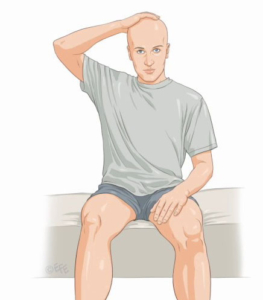Orthopedic Tests
Musculoskeletal System Examination
Cervical Spine Tests
– Spurling/neck compression test:

Purpose: Diagnosis of cervical radiculopathy
Description: A positive test is reproduction of radicular symptoms distant from the neck with passive lateral flexion and compression of the head.
Sensitivity: 40-60 %
Specificity: 92-100%
– Shoulder abduction (relief) sign:

Purpose: Diagnosis and conservative management of patients suffering from cervical radiculopathy
Description: A positive test is relief or reduction of ipsilateral cervical radicular symptoms with active abduction of the ipsilateral arm with the hand on the head.
Sensitivity: 43-50 %
Specificity: 80-100 %
– Neck distraction test:
– Lhermitte sign:
– Hoffmann sign:
Thoracic Outlet Tests
– Adson test
– Wright hyperabduction test
– Roos test
– Costoclavicular test
Rotator Cuff/Supraspinatus Tests
– Empty can/supraspinatus test
– Drop arm test
Rotator Cuff/Infraspinatus and Teres Minor Tests
– Patte test
– Lift-off test
Scapular Tests
– Lateral scapular slide test
– Isometric pinch test
– Scapular assistance test
– Scapular retraction test
Biceps Tendon Tests
– Yergason test
– Speed test
Shoulder Impingement Tests
– Neer’s sign test
– Hawkin test
– Yocum test
Shoulder Stability Tests
– Apprehension test
– Fowler’s sign
– Load and shift test
Labral Disorder Tests
– Active compression test (O’Brien)
– Crank test
– Compression-rotation test
AC Joint Tests
– Apley scarf test
Lateral and Medial Epicondylitis Tests
– Resisted wrist extension
– Resisted wrist flexion and pronation
Elbow Stability Tests
– Posterolateral rotatory instability
– Varus stress
– Jobe test (valgus stress)
– Moving valgus stress test
Carpal Ligament and Joint Tests
– Reagan test (lunotriquetral ballottement test)
– Watson test (scaphoid shift test)
– Shear test to assess the lunate triquetral ligament
– Ulnocarpal stress
– Finkelstein test
– Thumb basilar joint grind test
Median Nerve Tests at the Wrist
– Carpal compression test
– Phalen test (wrist flexion)
– Wrist extension test (reverse Phalen test)
– Tinel’s sign at the wrist
Source: BRADDOM’S – PHYSICAL MEDICINE & REHABILITATION